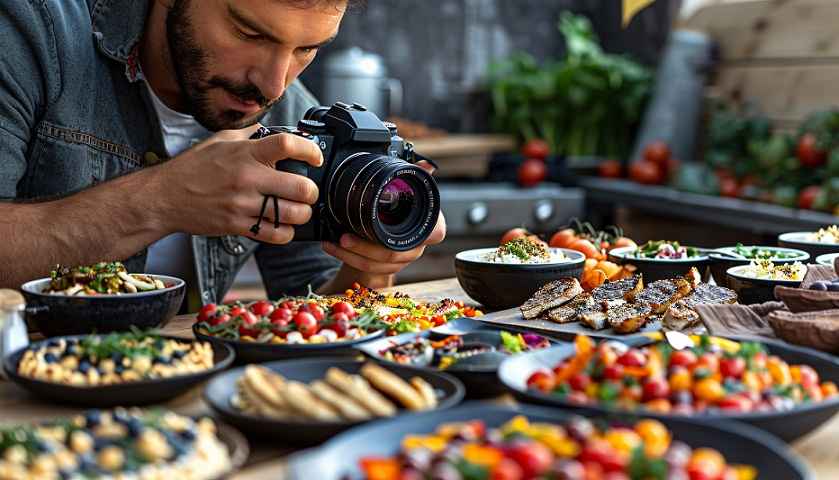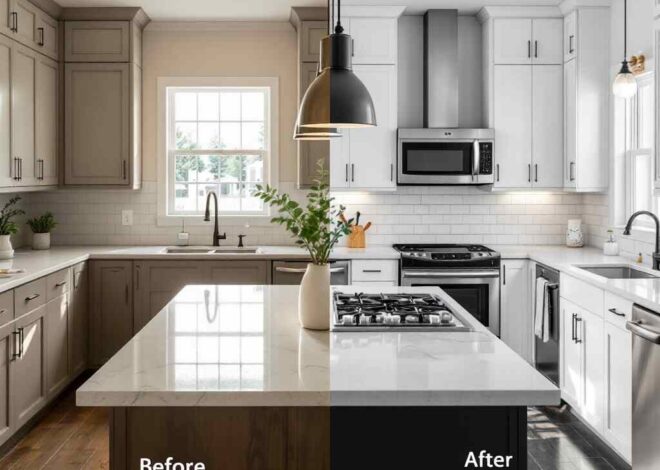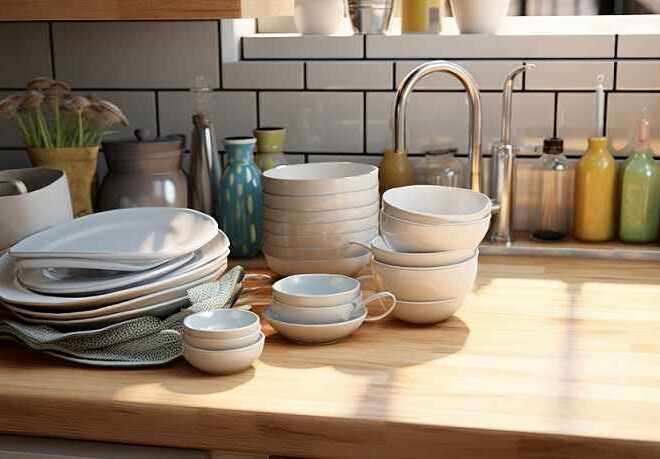
Crafting Your Culinary Haven: A Step-by-Step Guide to Creating the Perfect Kitchen Mood Board
Crafting Your Culinary Haven: A Step-by-Step Guide to Creating the Perfect Kitchen Mood BoardWelcome to your culinary sanctuary, where every meal transforms into a masterpiece and every gathering is infused with warmth! If you’ve ever dreamed of a kitchen that inspires creativity and joy, you’re in the right place. In this post, we’ll guide you through the art of crafting a mood board that captures your unique style and sets the tone for your ideal cooking space. Whether you’re revamping an existing kitchen or starting from scratch, a well-constructed mood board will help you visualize colors, textures, and themes that resonate with your personality. So grab some magazines, swatches, and maybe even a cup of coffee—it’s time to unleash your inner designer and turn those kitchen dreams into reality! Let’s dive in!
Introduction: Introduce the concept of a kitchen mood board and how it can help in designing a dream kitchen.
Your kitchen is more than just a place to cook; it’s the heart of your home. Creating an inviting and functional space can greatly enhance your dining experiences and daily routines. But where do you start? Enter the kitchen mood board—a powerful tool that brings your vision to life.
A mood board serves as a visual guide, helping you explore colors, materials, textures, and styles in one cohesive layout. Whether you’re planning a complete remodel or simply refreshing your current decor, this step-by-step approach will provide clarity and inspiration every step of the way. Let’s dive into crafting your culinary haven with ease!
What is a Kitchen Mood Board? Explain what a mood board is and how it can be applied to kitchen design.
A kitchen mood board is a visual collage that captures the essence of your dream kitchen. It’s a creative tool designed to express ideas, styles, and color palettes before diving into the actual design process.
Mood boards can include images, textures, colors, and even materials you envision for your space. This helps clarify what resonates with you aesthetically.
When it comes to kitchen design, using a mood board allows for exploration without commitment. You can experiment with various combinations of elements like cabinetry finishes or countertop materials.
Once assembled, this collection serves as inspiration throughout your renovation journey. It keeps your vision focused while guiding decisions about layout and decor choices in creating an inviting culinary haven.
A kitchen mood board is a visual representation of the style and ambiance you want to create in your kitchen. It serves as an essential tool in the design process, helping you organize your ideas, colors, textures, and overall aesthetic into one cohesive concept.
At its core, a mood board is a collage of images, textures, colors, and materials that inspire you. It can be created using physical materials such as magazine cutouts, fabric swatches, and paint chips or digitally using online tools like Canva or Pinterest. The purpose of a mood board is to capture the essence of your vision for your kitchen space and guide the decision-making process.
Creating a kitchen mood board can bring clarity to your design goals by allowing you to see how different elements work together before committing to any specific choices. It helps to avoid costly mistakes by giving you a tangible representation of your ideas rather than relying on imagination alone.
When it comes to applying a mood board specifically to kitchen design, there are several key aspects that should be considered:
- Color Scheme: A color palette is crucial in creating the right atmosphere in any room. A mood board can help you experiment with different color combinations until you find one that fits best with your desired theme. You can use images or paint swatches on your mood board to get an idea of how specific hues will look together.
- Materials and Textures: From countertops and backsplashes to flooring and cabinetry, there are countless options for materials when designing a kitchen. A mood board allows you to compare various textures side by side so that you can determine which ones complement each other best.
- Lighting: Lighting plays a significant role in setting the tone for any space; therefore it should not be overlooked when creating a kitchen mood board. Whether natural light or artificial lighting options like pendant lights or under-cabinet lighting fixtures – including these on your mood board will help visualize how they will impact the overall design.
- Furniture and Decor: A kitchen mood board can also include elements like furniture, accessories, and decor pieces to give you a sense of how they will fit into the overall design. This step is particularly helpful if you are looking to incorporate vintage or unique items into your kitchen.
Creating a kitchen mood board serves as an essential first step in the design process. It allows you to explore different options, determine what works best for your space, and ultimately create a cohesive and visually appealing kitchen that reflects your personal style.
Benefits of Using a Kitchen Mood Board: Discuss the advantages of using a mood board for kitchen design, such as organization, inspiration, and visualization.
A kitchen mood board serves as a powerful tool in the design process. It helps organize your thoughts and ideas, making the overall vision clearer.
By gathering images, colors, and textures that resonate with you, inspiration flows more freely. You can explore various styles without feeling overwhelmed.
Visualization is another key advantage. A well-crafted mood board allows you to see how different elements come together before committing to any purchases or renovations. This reduces costly mistakes down the line.
Additionally, it encourages creativity. Mixing unexpected materials or color palettes becomes easier when everything is laid out visually.
Ultimately, a kitchen mood board fosters communication if you’re working with designers or contractors. Sharing your vision clearly ensures everyone is on the same page from start to finish.
A kitchen is not just a place for cooking and preparing meals, it is the heart of the home where families gather and memories are made. Therefore, it is essential to design a kitchen that reflects your personal style and meets your practical needs. One of the most useful tools for planning and designing your dream kitchen is a mood board.
A mood board, also known as an inspiration board or design board, is essentially a visual representation of all the elements that you want to incorporate into your kitchen design. It can be created on a physical board using images, fabric swatches, paint chips, and other materials or digitally using various online tools. Here are some of the benefits of using a mood board for your kitchen design:
- Organization: Creating a mood board allows you to organize all your ideas in one place. As you collect images and samples of different materials such as countertops, cabinets, flooring, lighting fixtures, etc., you can arrange them on your mood board to get a clear picture of how they work together. This will help you avoid making costly mistakes during the actual renovation process.
- Inspiration: A mood board serves as an endless source of inspiration for your kitchen design project. You can use it to explore different color schemes, textures, patterns, and styles until you find what truly speaks to you. By bringing all your ideas together in one place visually, it becomes easier to see what works well together and what doesn’t.
- Visualization: It’s often difficult to visualize how different elements will come together in space without actually seeing them in person. This is where creating a mood board comes in handy – it allows you to see how each element looks when placed next to each other before committing to any purchase or installation decisions.
- Collaboration: If you’re working with an interior designer or contractor on your kitchen renovation project, sharing your mood board with them can help them understand exactly what you have in mind. It also allows for better communication and collaboration between you and the design professional, ensuring that your vision is brought to life accurately.
- Budgeting: A mood board can also help you stay within your budget by allowing you to compare prices and materials easily. You can include notes or labels on your board with the associated costs of each item, which will give you a clearer idea of how much your dream kitchen will cost.
A kitchen mood board is an essential tool for anyone looking to create their perfect culinary haven. With its organization, inspiration, visualization, collaboration, and budgeting benefits, it’s a valuable step in the design process that shouldn’t be skipped. So gather all your ideas and start creating your dream kitchen on a mood board today!
Step 1: Identify Your Style and Theme. Guide readers on how to determine their style and theme for
To start your kitchen mood board creation, it’s essential to identify your style and theme. Begin by exploring various design aesthetics that resonate with you. Are you drawn to modern minimalism, rustic farmhouse charm, or perhaps a cozy cottage vibe?
Gather inspiration from magazines, Pinterest boards, or even your favorite cookbooks. Pay attention to colors, textures, and materials that catch your eye. Create a list of words or phrases that encapsulate the feelings you want in your kitchen space.
Next, consider how you use the kitchen daily. Is it primarily for cooking gourmet meals or more for casual family gatherings? Tailoring the design around functionality will help bring clarity to your theme choice.
Mood boards are visual tools; they should reflect not just what looks good but also what feels right in terms of style and practicality. Don’t hesitate to mix styles if that reflects who you are! The goal is to create an atmosphere where you’ll feel inspired every time you’re in this culinary haven.
As you sift through visuals and compile ideas on paper or digital platforms like Canva or Adobe Spark, keep refining until everything aligns with the vision you’ve crafted for yourself. This foundational step sets the stage for an exciting journey ahead in transforming your dream kitchen into reality.
Step 1: Identify Your Style and Theme
The first step in creating the perfect kitchen mood board is to identify your own personal style and theme. This will serve as the foundation for all other decisions you make while designing your culinary haven. It’s important to take some time to really think about what kind of atmosphere you want your kitchen to have – do you envision a modern, sleek space or a cozy, rustic one? Do you prefer bright pops of color or a more muted palette? These are all questions that will help guide you in determining your style and theme.
To begin, gather some inspiration from various sources such as home decor magazines, Pinterest boards, or even restaurants and cafes that you admire. Take note of elements that catch your eye – is it the clean lines of a minimalist design or the warmth of wooden accents? Keep track of these inspirations by saving images or making notes so that you can refer back to them later on.
Next, start thinking about how you want your kitchen to feel. Consider adjectives like inviting, cozy, sophisticated, or vibrant – these words will help guide you in determining the overall mood and tone of your space. Are there any specific memories or experiences that evoke these feelings for you? Perhaps a childhood trip to Tuscany has left you with a love for rustic Italian charm, or maybe summers spent at the beach have instilled a desire for coastal vibes. Use these connections to further refine your style and theme.
Another helpful tool in identifying your style is taking note of what already exists in your home. Is there an overarching aesthetic throughout your living spaces? If so, consider incorporating similar elements into your kitchen design to create cohesion throughout your home.
Once you have gathered enough inspiration and determined key themes and feelings for your kitchen space, it’s time to narrow down and define your style into one cohesive vision. This could be anything from modern farmhouse chic to eclectic bohemian. As you begin to solidify your style, consider creating a mood board or collage to visually represent your ideas. This will serve as a helpful reference point throughout the design process.
Remember, this is your kitchen and it should reflect your personal style and preferences. Don’t be afraid to mix and match different elements to create a unique and personalized space. By following these steps and taking the time to identify your style and theme, you’ll be well on your way to crafting the perfect kitchen mood board for your culinary haven.


